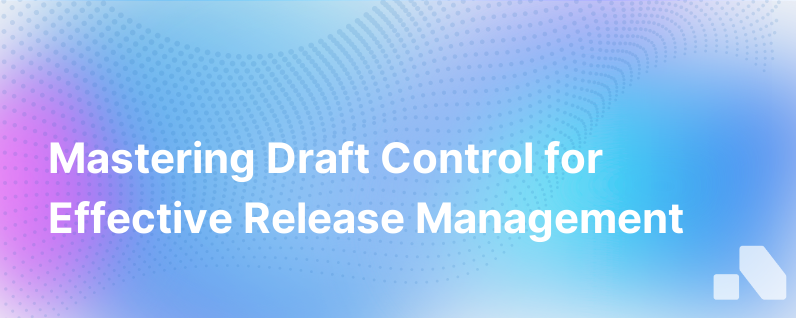
Draft control release is an essential part of the software development process, particularly within the realm of continuous development environments. It helps ensure usability and effectiveness of new features and improved functionality in software products. Here's a comprehensive guide on the subject for anyone who wants to understand it in depth.
Understanding Draft Control Release
Draft control release is an integral part of the software release management process that involves managing, planning, scheduling, and controlling a software build through different stages and environments, including testing and deploying software releases.
In simple terms, before a new feature or an enhancement to a software product gets released into the live or production environment, it's first created as a 'draft release'. This draft release undergoes a multitude of checks and balances (like being tested by QA teams under controlled conditions) to ensure it is ready for the final release without impacting the existing live environment.
Draft control release strategy helps in systematically planning for a software release, reducing the risk of something going wrong during the deployment, and providing a smooth user experience post-deployment. The approach is targeted towards improving the reliability, quality, and speed of software releases.
The Importance and Benefits of Draft Control Release
Implementing draft control releases offer several benefits, including:
- Risk Reduction: Draft control release helps in detecting potential bugs and issues early in the development process, thereby reducing the risk of malfunctioning features in the final release.
- Improved Quality: Quality assurance teams thoroughly test the draft releases in controlled environments, allowing for thorough quality checks before the final release.
- User Experience: Draft control releases ensure that the software update doesn't disrupt user experience. Changes are gradually released and refined, lending stability to your users' experience.
- Continuous improvements: Draft control releases allow for continuous software improvements and updates, ensuring the software remains relevant, useful, and beneficial to the users.
Steps in the Draft Control Release Process
The draft control release process generally includes the following steps:
-
Development: This initial phase involves coding and configuring the software updates. Developers create a draft release with new features, improvements, or fixes.
-
Building: In this step, the draft release (individual pieces of code) are compiled into executable file(s). The resultant software should be free of compilation errors and ready for testing.
-
Testing: The quality assurance (QA) team tests the draft release in a controlled environment to detect issues or bugs. It may be subjected to various forms of testing like unit testing, functional testing, integration testing, system testing, and user acceptance testing.
-
Staging: Pre-release version of the software is deployed to a staging environment that closely mirrors the live or production environment. This allows for further testing in an environment that resembles the final destination as closely as possible.
-
Release: After successfully passing through all tests, the software draft release is deemed stable and ready to be deployed into the production environment. The release is scheduled, deployed, validated, and handed off to operations.
-
Review and Monitoring: After the final release, the software is continuously monitored for any problems. If any issues are detected, it can roll back to the previous stable version. The feedback from production releases is used to inform future draft releases.
Conclusion
Draft control release strategy is a pragmatic approach to ensure high quality and efficient software releases. It provides an environment for catching issues early and making amendments, thereby reducing the risk of post-deployment issues and minimizing disruption to the end-user.
When done right, draft control releases contribute significantly towards the delivery of a reliable, robust, and valuable software product, ensuring the software stays relevant and beneficial.
As an AI-driven software platform, Aomni helps streamline the draft control release process. Our system puts a focus on creating drafts, performing stringent testing procedures, and ensuring an overall improved quality product each time new features are introduced or existing ones are enhanced. This is why businesses trust our platform for their B2B sales, knowing that our commitment to continuous development and improvement will help them sell more strategically.